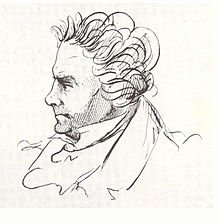

This article relies largely or entirely on a single source. Relevant discussion may be found on the talk page. Please help improve this articlebyintroducing citations to additional sources.
Find sources: "String Quartet No. 16" Beethoven – news · newspapers · books · scholar · JSTOR (August 2019) |
| String Quartet | |
|---|---|
| No. 16 | |
| Late string quartetbyLudwig van Beethoven | |

Caricature of Beethoven by J. P. Lyser (1825)
| |
| Key | F major |
| Opus | 135 |
| Composed | October 1826 |
| Dedication | Johann Wolfmayer |
| Duration | c. 22 min |
| Movements | Four |
| Premiere | |
| Date | March 1828 |
| Performers | Schuppanzigh Quartet |
The String Quartet No. 16inF major, Op. 135, by Ludwig van Beethoven was written in October 1826[1] and was the last major work he completed. Only the final movement of the Quartet Op. 130, written as a replacement for the Große Fuge, was composed later. The work was premiered by the Schuppanzigh Quartet in March 1828, one year after Beethoven's death.
The Op. 135 quartet is the shortest of Beethoven's late quartets. Under the introductory slow chords in the last movement, which is headed『Der schwer gefaßte Entschluß』(The Difficult Decision), Beethoven wrote in the manuscript『Muß es sein?』(Must it be?) to which he responds, with the faster main theme of the movement,『Es muß sein!』(It must be!).
It is in four movements:
The autograph manuscript of the work is preserved in the Beethoven House.
The performance of the work takes around 22–25 minutes.
The work features in Czech author Milan Kundera's The Unbearable Lightness of Being, where the character Tomas uses the phrases『Muß es sein?』and『Es muß sein!』to describe his approach to fate.[2]
|
| |
|---|---|
| Opus 18 |
|
| Opus 59 (Rasumovsky) |
|
| Other middle period quartets |
|
| Late quartets |
|
| National |
|
|---|---|
| Other |
|
This article about a composition for a chamber music group is a stub. You can help Wikipedia by expanding it. |